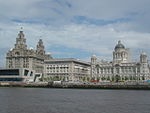Municipal Buildings, Liverpool
| Municipal Buildings | |
|---|---|
 Municipal Buildings, Dale Street | |
| Location | Dale Street, Liverpool, Merseyside, England |
| OS grid reference | SJ 3490 |
| Built | 1862–1868 |
| Architectural style(s) | Second Empire style |
| Governing body | Historic England |
Listed Building – Grade II* | |
| Designated | 12 July 1966 |
| Reference no. | 1068281 |
Municipal Buildings is a former council office building that has been converted into a hotel.[1] It is located on Dale Street in the centre of Liverpool, England. It is a Grade II* listed building.[2]

History
[edit]The building was built by the town council to accommodate the growing number of administrative staff. Work was started in 1862 by Liverpool Corporation surveyor John Weightman, and finished by Edward Robert Robson in 1868.[2] The building was put up for sale by the council in 2016 as it was deemed "surplus to requirements" and too expensive to run and maintain.[3]
In January 2016, it was announced that Singapore-based international property group Fragrance Group had bought the building and were planning on turning it into a hotel.[4] The remaining 640 council staff then working in the building were moved to other offices within the city ahead of the sale.[5] Work began in autumn 2020.[6]
The project was worth £80 million[7] including the acquisition costs, and involved the creation of a four storey extension at the back of the building, allowing the facility to have a pool, spa, gym and space for 179 suites and bedrooms for guests.[8]
The building opened on 10 May 2023 as 'The Municipal Hotel Liverpool, MGallery' by Accor the French multinational hotel chain.[1][9]
Architecture
[edit]The quadrangular building has three storeys and is built of stone with a lead roof. The Dale Street frontage is over 220 ft (67 m) wide and the sides of the building extend back 197 ft (60 m) along Crosshall Street and Sir Thomas Street.[10] Pavilions at each corner are topped by convex-hipped mansard-style roofs with ornamental ironwork.[10] The design of the building was influenced by the Second Empire style.[2] Distributed along the attic storey are eighteen sandstone figures representing the arts, sciences and industries of Liverpool (see gallery below).[2]
In the centre of the building, above the main Dale Street entrance, is a 210 ft (64 m) tower containing a clock and five bells; (the clock was by Messrs Pendlinton & Hutton of Liverpool, the bells by Warner & Sons).[10] The four quarter bells are hung for English-style Change Ringing. A two-stage pyramidal spire is situated on the top the tower.[11] There are balconies at the belfry level and clock level, and halfway up the spire.[2]
Inside, the building contained the offices of various officials (which had previously been scattered in different locations around the city).[2] The principal offices were at ground-floor level. Directly behind the main entrance hall was the Treasurer's Public Office, a two-storey hall which filled the centre of the internal quadrangle. To the left were the offices of the Borough Engineer, the Treasurer and the Medical Officer of Health; to the right were the Town Clerk, Deputy Town Clerk and Water Engineer. There were also several committee rooms on this side. At first floor level, the principal offices facing Dale Street were occupied by the Borough Architect and Surveyor. The clerks of the various department were accommodated in offices on the upper floors.[2]
Gallery of Statues
[edit]-
Europe, Dale Street front
-
America, Dale Street front
-
Asia, Dale Street front
-
Africa, Dale Street front
-
Agriculture, Dale Street front
-
Manufacturing, Dale Street front
-
Cotton, Dale Street front
-
Navigation, Dale Street front
-
Astronomy, Dale Street front
-
Trade, Dale Street front
-
Literature, Sir Thomas Street front
-
Music, Sir Thomas Street front
-
Art, Sir Thomas Street front
-
Architecture, Sir Thomas Street front
-
Engineering, Crosshall Street front
-
Building, Crosshall Street front
-
Electricity, Crosshall Street front
-
Medicine, Crosshall Street front
See also
[edit]References
[edit]- ^ a b "First look inside the new Municipal Hotel that "beats The Dorchester" in London". Liverpool Echo. 10 May 2023. Retrieved 11 July 2023.
- ^ a b c d e f g Historic England. "Municipal Buildings, Liverpool (1068281)". National Heritage List for England. Retrieved 10 April 2020.
- ^ "Liverpool City Council to sell Grade II* listed Municipal Buildings". BBC News. 30 September 2016. Retrieved 1 January 2017.
- ^ Houghton, Alistair (26 January 2017). "Municipal Buildings SOLD to Singapore firm". Liverpool Echo. Retrieved 26 January 2017.
- ^ Houghton, Alistair (31 December 2016). "Remembering Liverpool's Municipal Buildings". Liverpool Echo. Retrieved 1 January 2017.
- ^ Hougton, Tom (30 November 2020). "Inside Liverpool's Municipal Building as £40m hotel transformation begins". Business Live. Retrieved 30 November 2020.
- ^ "Far East property developers launch luxury scheme in Devon". The Business Desk. 17 May 2024. Retrieved 4 June 2024.
- ^ "£40m Liverpool hotel project hits major milestone". Liverpool Business News. 25 October 2021. Retrieved 28 October 2021.
- ^ "The Municipal Hotel Liverpool - MGallery (Opening Summer 2023)". all.accor.com.
- ^ a b c "New Municipal Offices, Liverpool". The London Journal. LI (1301): 36–37. 15 January 1870.
- ^ "Looking back at Liverpool's Municipal Buildings". Liverpool Echo. 31 December 2016. Retrieved 10 April 2020.






















